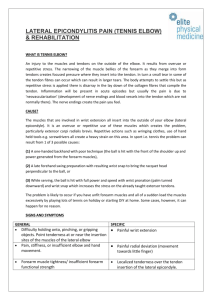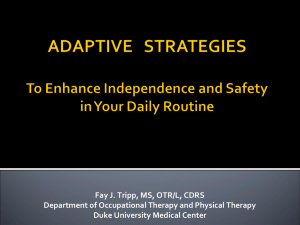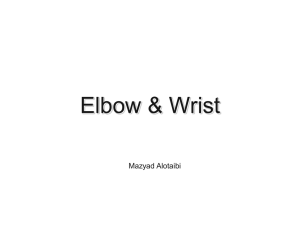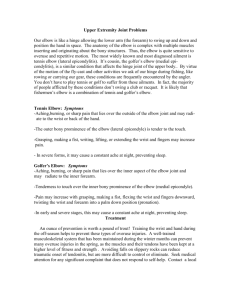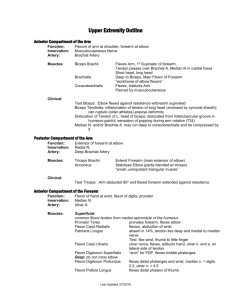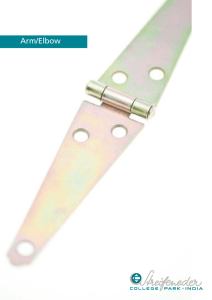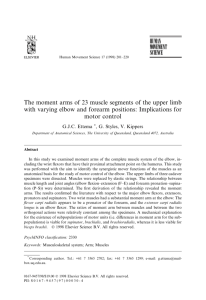Tennis Elbow and Golfer`s Elbow
advertisement
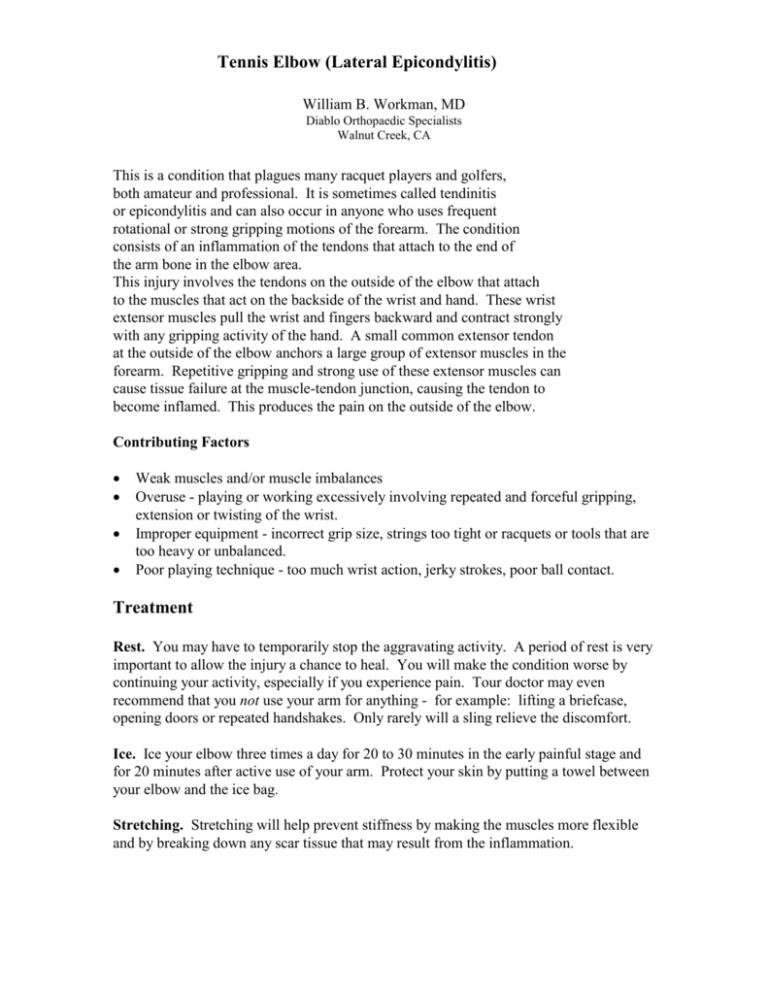
Tennis Elbow (Lateral Epicondylitis) William B. Workman, MD Diablo Orthopaedic Specialists Walnut Creek, CA This is a condition that plagues many racquet players and golfers, both amateur and professional. It is sometimes called tendinitis or epicondylitis and can also occur in anyone who uses frequent rotational or strong gripping motions of the forearm. The condition consists of an inflammation of the tendons that attach to the end of the arm bone in the elbow area. This injury involves the tendons on the outside of the elbow that attach to the muscles that act on the backside of the wrist and hand. These wrist extensor muscles pull the wrist and fingers backward and contract strongly with any gripping activity of the hand. A small common extensor tendon at the outside of the elbow anchors a large group of extensor muscles in the forearm. Repetitive gripping and strong use of these extensor muscles can cause tissue failure at the muscle-tendon junction, causing the tendon to become inflamed. This produces the pain on the outside of the elbow. Contributing Factors Weak muscles and/or muscle imbalances Overuse - playing or working excessively involving repeated and forceful gripping, extension or twisting of the wrist. Improper equipment - incorrect grip size, strings too tight or racquets or tools that are too heavy or unbalanced. Poor playing technique - too much wrist action, jerky strokes, poor ball contact. Treatment Rest. You may have to temporarily stop the aggravating activity. A period of rest is very important to allow the injury a chance to heal. You will make the condition worse by continuing your activity, especially if you experience pain. Tour doctor may even recommend that you not use your arm for anything - for example: lifting a briefcase, opening doors or repeated handshakes. Only rarely will a sling relieve the discomfort. Ice. Ice your elbow three times a day for 20 to 30 minutes in the early painful stage and for 20 minutes after active use of your arm. Protect your skin by putting a towel between your elbow and the ice bag. Stretching. Stretching will help prevent stiffness by making the muscles more flexible and by breaking down any scar tissue that may result from the inflammation. Physical Therapy. In some cases, your doctor may prescribe physical therapy to reduce the inflammation in your arm. Exercises to strengthen the forearm muscles can begin as the inflammation in the tendon subsides. Building strength will help protect the inflamed tendon and prevent the injury from happening again. Medication. Your doctor may prescribe anti-inflammatory/analgesic medication (in tablet form), or an injection of cortisone and local anesthetic directly into the tendon area. After receiving a cortisone injection, you should not play sports or use the arm forcefully for at least 2 weeks. Brace. Your doctor may recommend a counter-force brace which is worn one to two inches below the elbow. This type of brace gives compression to the forearm muscles and helps lessen the force that the muscle transmits to the tendon. At first, the brace may be worn at all times when the tendon is acutely inflamed. Later, as the inflammation subsides, the brace is only necessary for protection during activities which will stress the injured arm. Surgery. Surgery is rarely required but is sometimes recommended in chronic or recurrent cases. Returning to Sports Warm up. Always warm up carefully before you play. Put all of your major joints through their complete range of motion and work up a “sweat” prior to stepping on the tennis court or golf course. Follow this by slowly performing the motions that you use in your sport. In tennis, do easy strokes next, and then slowly increase your intensity until you are sweating again. The forearm muscles should be stretched well after the warm up, and when you are through playing. Your Racquet. Use a lighter weight racquet and move your hand up a bit on the grip. Change to a racquet that has greater spring. Reduce your string tension. Grip size can also be an important factor. If possible, discuss equipment with your local pro. Your Stroke. In tennis, the backhand, the serve or the overhead stroke may be damaging to your elbow if they are not done well. The two-handed backhand tends to be easier on your elbow. Avoid the shots that aggravate the problem. Reduce wrist motion to a minimum. Lessons may be necessary to alter your strokes. Your Game. When you go back to your sport, start back slowly. In tennis, rally at first for only short periods of time, avoiding problem shots. Play less time each day or play doubles. Avoid playing competitive games until your elbow is healed. In golf start with only putting and chip shots. Slowly work up from a few holes to a complete game. Exercises Exercises to stretch and strengthen the muscles attached to the injured tendon will help with the healing process. Stretches and exercises should be avoided if they are painful. The following exercises can be done every other day until your symptoms subside. Continue to use the exercises as a warm-up before tennis, golf or other gripping activities. Resisted Wrist Flexion With tubing wrapped around the hand and the opposite end secured under foot, keep the palm facing up and bend the wrist and hand upward as far as you can. Hold one count and lower slowly 3 counts. Repeat 10 to 20 times, two times per day. This exercise can also be done with a dumbbell. Resisted Wrist Extension With tubing wrapped around the hand and the opposite end secured under foot, keep the palm facing down and bend the wrist and hand upward as far as you can. Hold 1 count and lower slowly 3 counts. Repeat 10 to 20 times, two times per day. This exercise can also be done with a dumbbell. Resisted Forearm Supination and Pronation Holding a dumbbell, with the forearm supported on your thigh, slowly turn the palm facing up and then slowly turn the palm facing down. Make sure to hold the elbow still and only move the forearm. Repeat 10 to 20 times each way, one to two times per day. Wrist Flexor Stretch Hold the arm with the elbow straight and the palm facing up. Grasp the involved hand at the fingers and stretch the wrist backward, until a stretch is felt on the inside of the forearm. Hold 15 seconds, repeat 3 to 5 times, 2 to 3 times per day. Wrist Extensor Stretch Hold the arm with the elbow straight and the palm facing down. Push downward on the back of the involved hand until a stretch is felt in the muscles on the outside of the forearm. Hold 15 seconds, repeat 3 to 5 times, 2 to 3 times per day.
